The English Championship was always a league stereotyped for its physicality and brute target men. It seemed that almost every team played a 4-4-2 and the objective was to play long to the centre-forwards and win the second balls in the box in an attempt to score.
However, in the past few years, it has begun to copy the trends of some of the best leagues and clubs in the world and nearly every team within the division has its own tactical identity, whether it be possession-based football, counter-attacking, direct play, etc, but the team with one of the most interesting tactical identities in the league is certainly Rotherham United.
Rotherham are managed by Paul Warne, one of their former players, and he has guided the club to two promotions to the Championship. They will be hoping to keep their place in the division for next season but are currently in a relegation battle with a number of sides.
Rotherham play a very high-pressing style of football, and currently have the lowest Passes Per Defensive Action (PPDA) in the Championship, one of the more surprising and interesting statistics in English football this season.
This article will be a tactical analysis in the form of a scout report. It will be an analysis of Warne’s Rotherham and how the team’s pressing tactics make them one of the best clubs to watch in the league this season.
Comparison with the rest of the league
Starting with the statistic at hand, Rotherham are currently averaging 8.42 PPDA. The team with the second-lowest are Bournemouth with 8.66.
PPDA indicates the number of passes a team allows their opposition to have before performing a defensive action, whether that be a successful defensive duel, an interception, or a foul on the ball-carrier.
They are also averaging 90.72 ball recoveries per 90 in all competitions, with 50.02 coming from the middle and final third of the field, which is 55.1 percent of their overall ball recoveries.
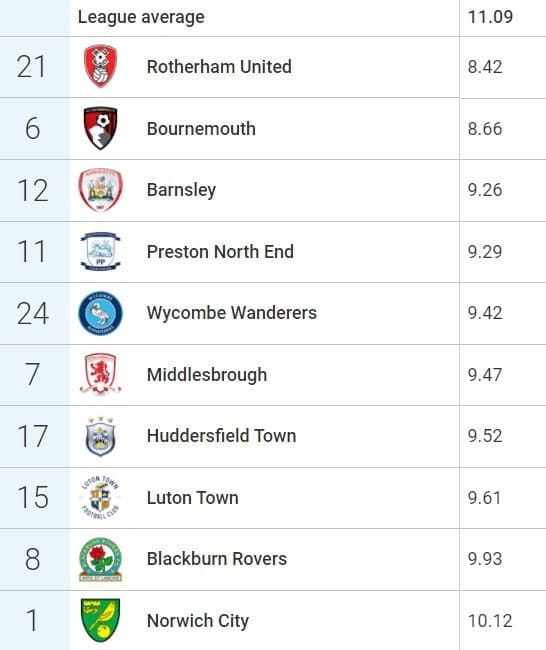
The table above shows the table of the teams with the lowest PPDA in the Championship with Warne’s side clearly top. Surprisingly, Rotherham are averaging a lower number than Norwich City, who are top of the division, by 1.7 PPDA.
What makes Rotherham so unique and intriguing in terms of their style is that they are 21st in the league as of writing. Straight off the bat, this tells us that whilst they press at an extremely high intensity, it can often leave them exposed at the back when teams play through them as they have conceded 35 goals already in the 2020/21 campaign, the fourth-highest in the league.
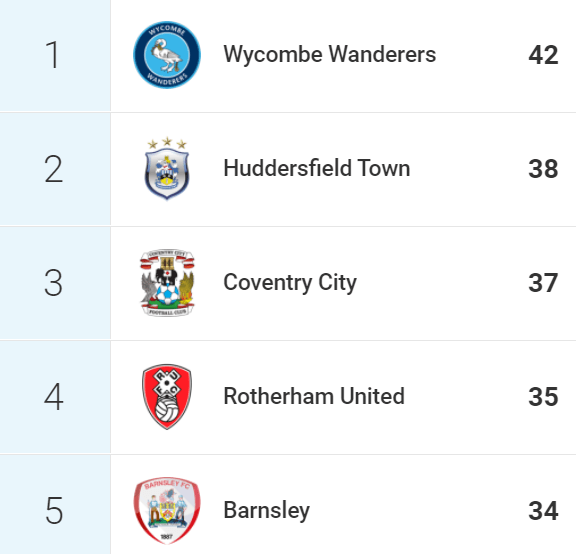
So, without diving into the actual analysis of their pressing system, are we to assume that their pressing style hinders them as much as it possibly aids them with their attacking play by turning over possession high up the pitch, or is their pressing structure helping to mask existing frailties within their backline, much like at Southampton?
We will find out later in this article by analysing their defensive system.
Cutting off one side of the pitch
Not only do Rotherham have the lowest PPDA in the Championship, but they also have the highest challenge intensity in the league with 7.6. Challenge intensity is correlated to PPDA and measures how actively a team looks for the ball when they are in the defensive phases of play by showing how intense their challenges are.
The Millers have used a 3-5-2 formation recently, which predominantly looks like a 5-3-2 when they do not have the ball. The 5-3-2 is the system they use when they actively look to engage in a press. The main goal when they press the opposition is to force them into one side of the pitch, cutting off the opposite side, and limiting their options to play out.
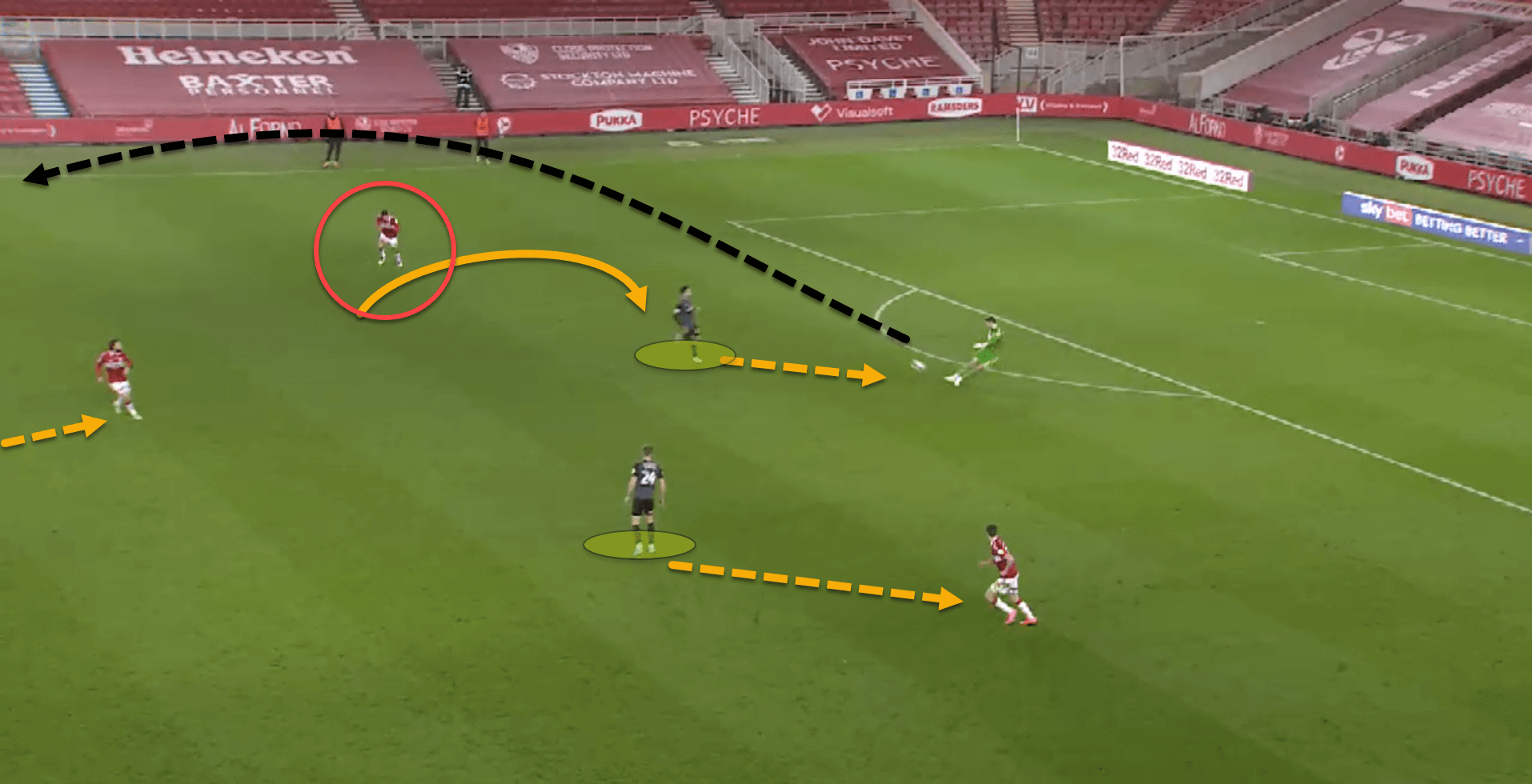
Here we can see this press in action. The two centre-forwards lead the press and are tasked with pressing both centre-backs when they have the ball as well as the goalkeeper.
When the ball is played into the goalkeeper or one of the centre-backs, the objective for the centre-forwards is to angle their run, cutting off the passing lane into the opposite central defender, which forces the other team to play into one area of the pitch or else play direct to bypass the press. We can see occur again in the following image:
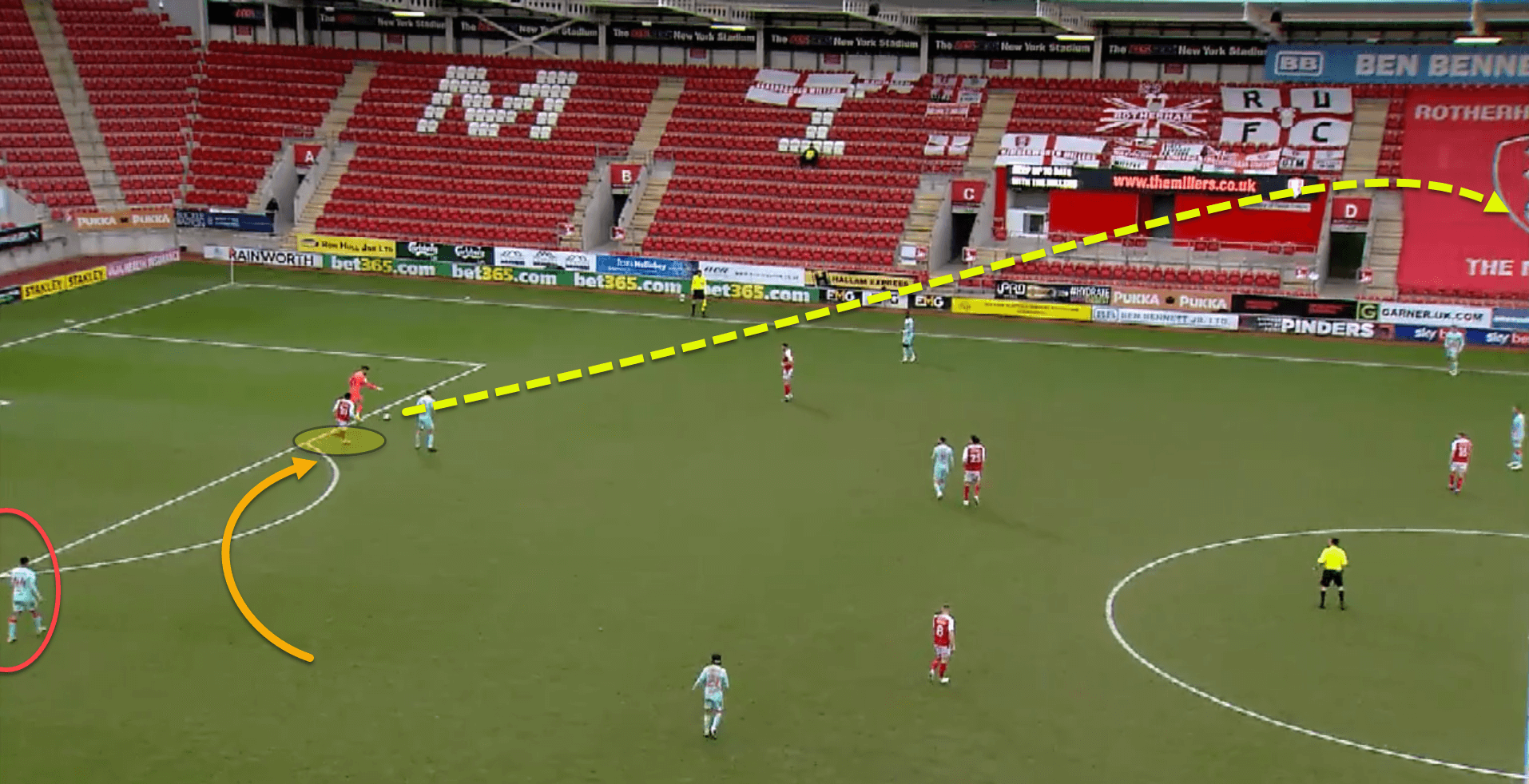
Cutting off one side of the pitch for the opposition allows Rotherham to contain where their opponents can play into, making it much more difficult to build-up their attacks from deep, which is particularly tough for sides who play a more possession-oriented style of play.
Rotherham’s pressing structure is a very man-oriented system and when they push their opponents into one area of the pitch, they man-mark the players, cutting off all passing lanes which in turn either forces the other team to play long or potentially make mistakes, turning over possession.
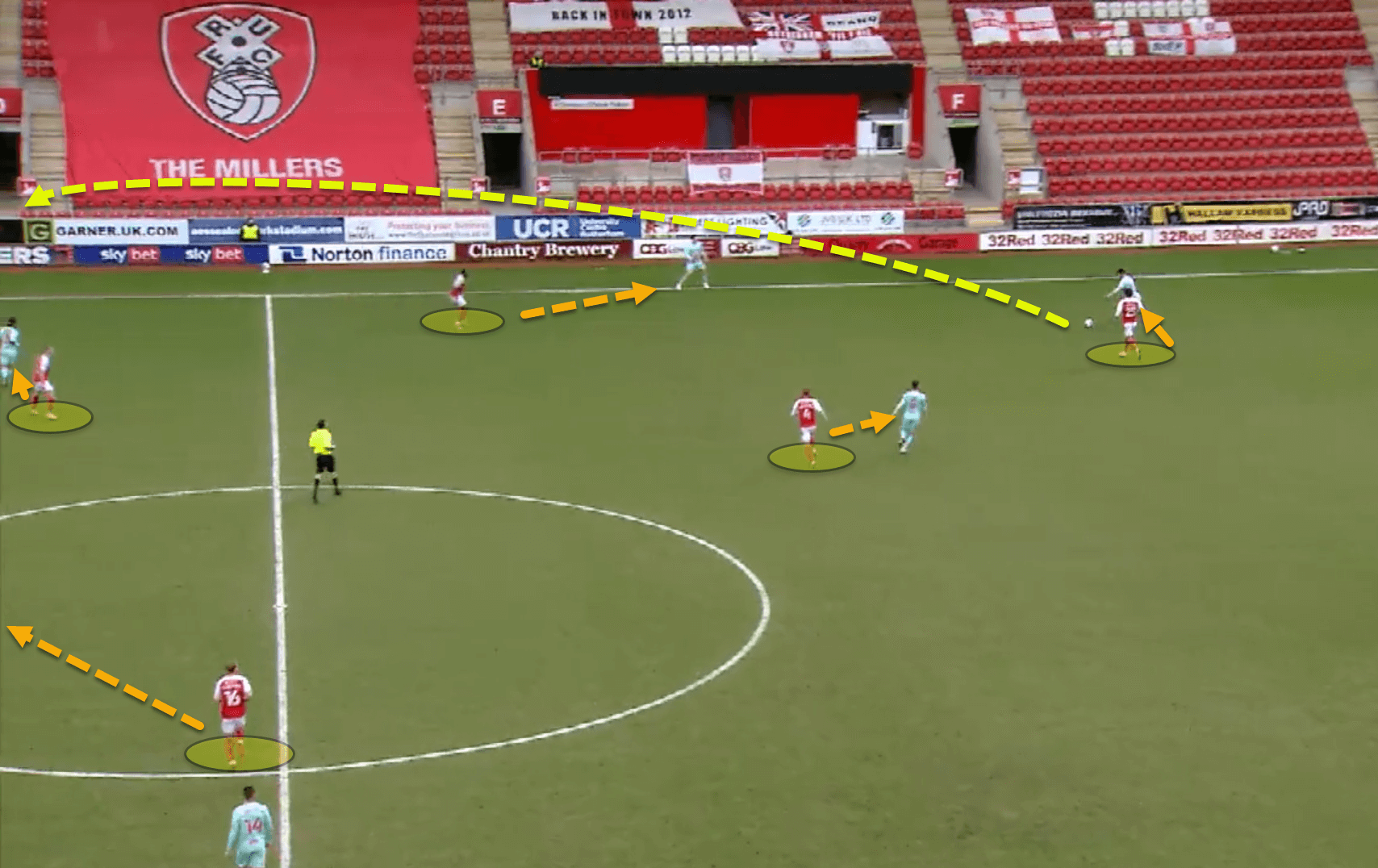
The image above portrays Rotherham’s man-marking structure when they press high in the wide areas. In this instance, Warne’s side have pushed Swansea over and boxed them in on the right flank by ensuring that they have marked each passing lane at close proximity.
The angle of the centre-forward’s run has cut off any possibility of the Swansea defender playing the ball across to the other centre-back. The only viable options would be to either turn and play back to the goalkeeper to rebuild the positional attack, or else play long, which was the outcome in this scenario.
Their pressing structure works in this sense. There are quite a few problems that will be analysed later in the article but in terms of containing their opposition’s build-up play, for the most part, they are efficient. They have even scored goals this season from pressing high up the pitch in this system.
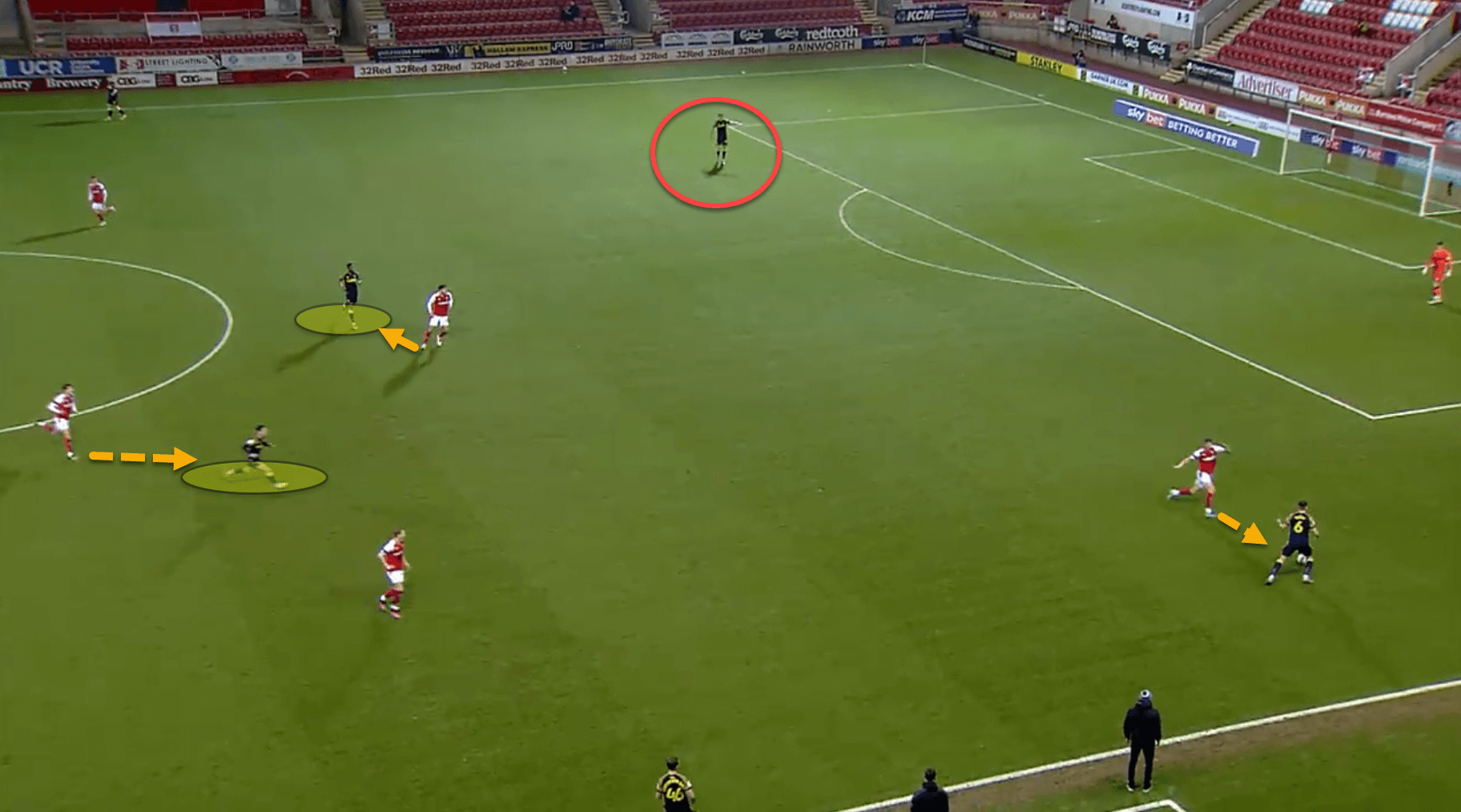
Regarding this excellent pressing goal against Stoke City, the ball-near centre-forward and supporting players cut off the passing lanes successfully, giving the centre-back the option of either direct up the field, or else turning back and playing to the goalkeeper.
In this instance, he chose the latter, but the centre-forward pounced before the defender could play the ball backwards, winning possession, allowing his side to transition whilst already in the final third, before scoring at the end of the move. A successful high press from the Millers.
Intense pressing at throw-ins
One of the most interesting ways Rotherham attempt to win back possession high up the pitch is through their intense pressing when the opposition have a throw-in.
Generally, when an opposing team has a throw-in back at their defensive third, the defending side will drop off, only committing a handful of bodies up to contest. However, Rotherham deploy quite a radical defensive system from throw-ins, pushing up the vast majority of players.
The objective is that when the attacking side throws the ball, Rotherham will be able to press with numerous bodies to win the ball back and transition forward.
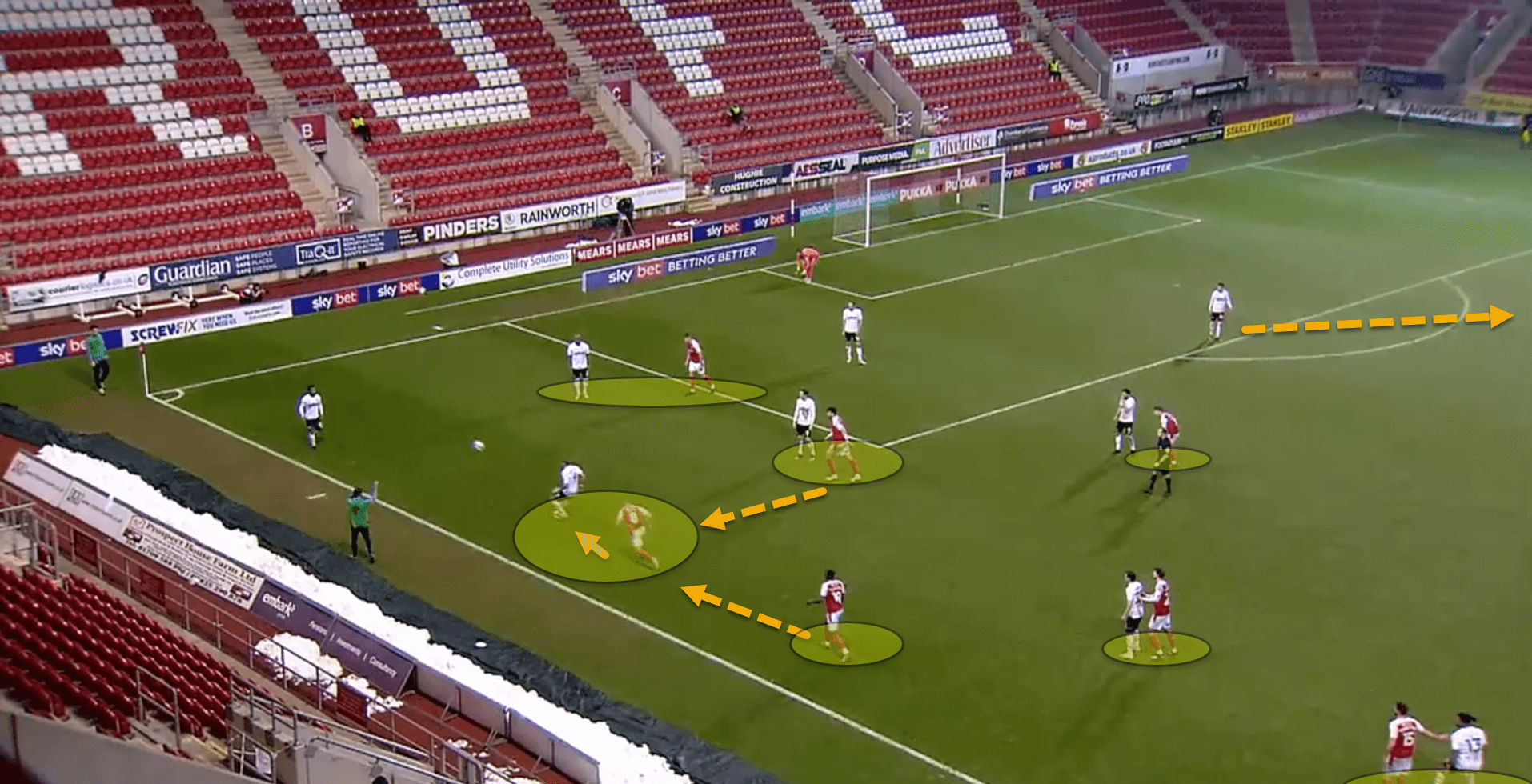
This is an example of how Warne sets his side up from an opposition throw-in up in their attacking third. In this situation, there are seven bodies within the camera shot, ensuring that each of their opponent’s options are marked, leaving a bit of space for one to receive before pouncing.
If they can quickly press the player who receives the ball from the throw with multiple players, it is very likely that they will regain possession in a very dangerous area, allowing them to attack the opponent while already in the final third.
The problem with this rather eccentric set-up is that it leaves them open on the far side of the pitch for a quick switch of the play, which can cost them severely as they have so many bodies on the ball-side of the pitch.
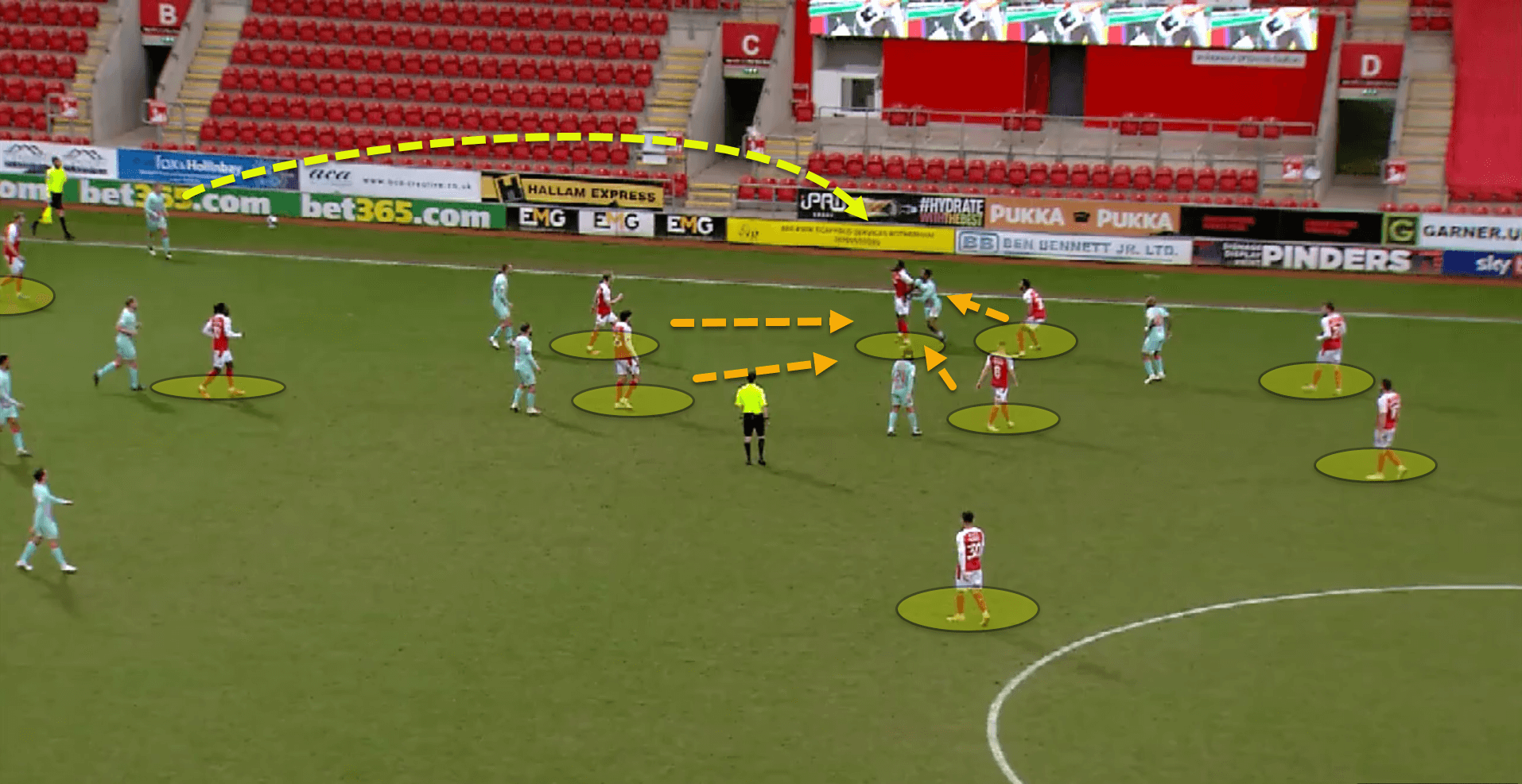
Again, we see Rotherham’s set-up from defensive throw-ins. This time, they have even more bodies over on the ball-side. Albeit the throw from Swansea was quite poor, the system is still very visible.
There are plenty of bodies around the two players contesting the header, which gives them a really high chance of being able to press successfully with numerical superiority and regain possession.
Problems with the man-oriented system
Whilst their high press can be very successful at times, as has been proved throughout this article, there is also a reason why Rotherham are at a high risk of being relegated, having one of the worst defences in the league as of writing.
At times, certainly against better opposition players, it can be far too easy for teams to play through their press with quick passing and good rotations and movement. As has been stated an abundance of times throughout this piece, Rotherham deploy a man-oriented pressing system.
However, the players do not press in coordination with one another, which can make it very easy for their opponents to find space by dragging Rotherham’s players out of position.
The preceding two images will show an instance where Norwich City carve open their man-oriented press in the midfield with intelligent movements and subtle passing.
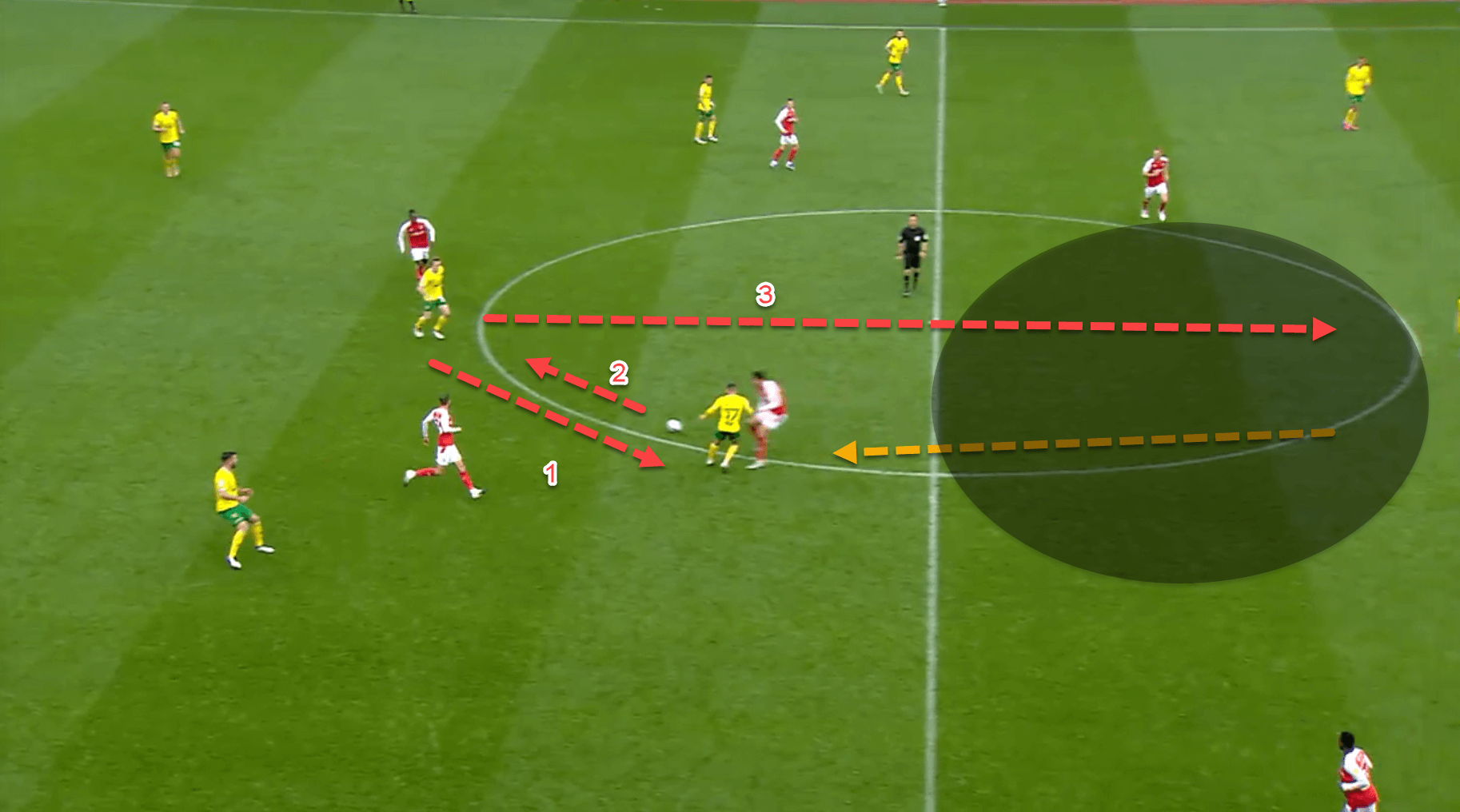
In this image, Norwich have utilised the up, back, and through passing method to play through Rotherham’s midfield. When the first pass is played, the nearest central midfielder is dragged out to close him down before the ball-player can turn on the ball.
In this intensity though, as the press is not coordinated, nobody covers his position, which allowed the ball-carrier to bounce the ball back and for the new receiver to play through into the gap behind.
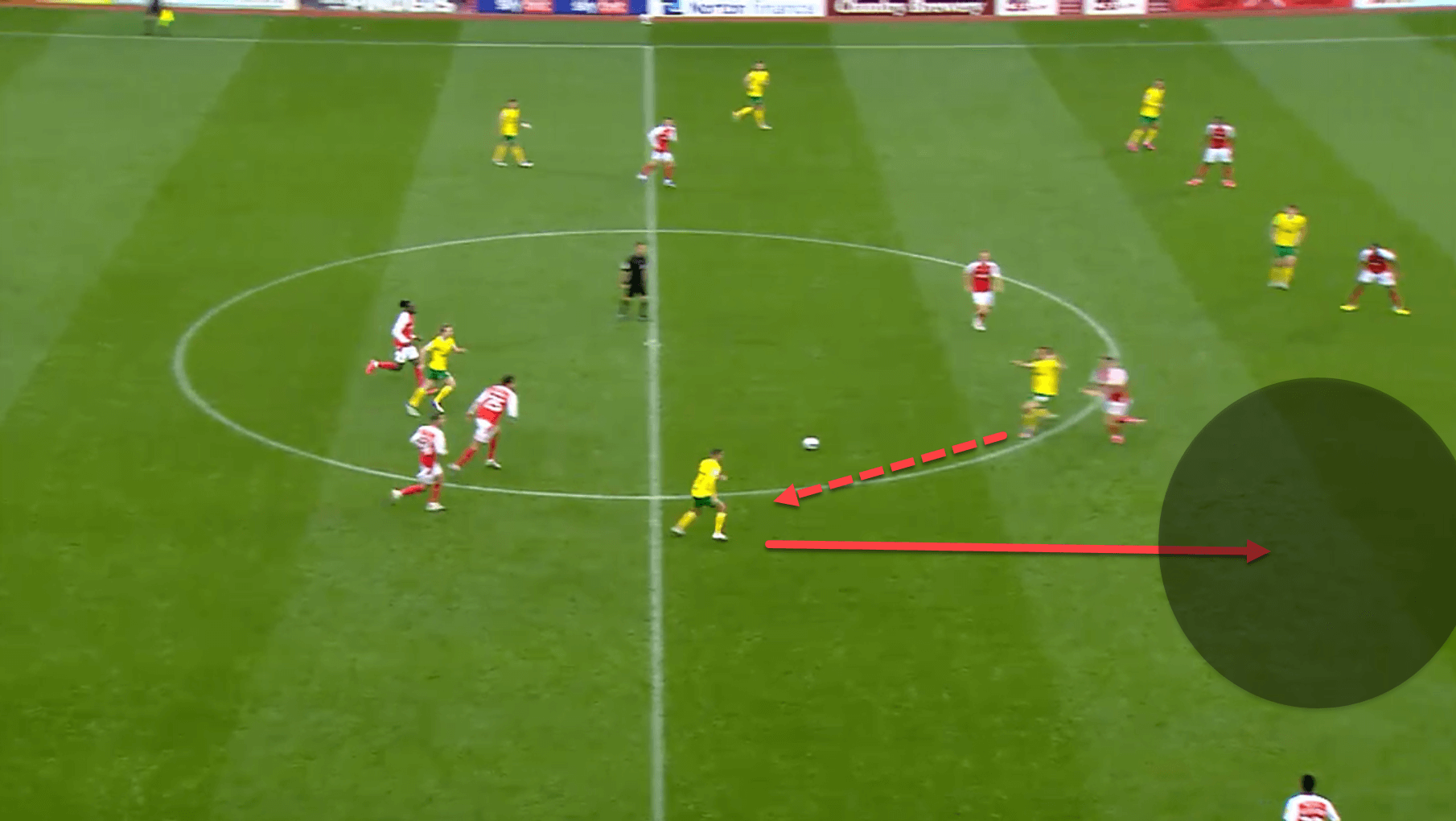
In the same movement, the Rotherham holding player is dragged out this time, which left space in behind. Once the Norwich player bounced the ball to the player on his left, he will have a free run at the backline to thread a through ball, which he does successfully before they eventually score.
The main problem, as seen here, with man-marking defensive systems, and pressing systems in particular, is that players must win their individual battles or else scenarios, such as the one above, can occur.
It took Norwich merely four passes, including the initial pass that broke through the first line of pressure, to carve through Rotherham’s frontline and midfield line as they had lost their individual battles, failing to stop a single pass in the process when their players engaged in the duels.
Counterpressing needs work
The final point, and a brief one, that will be made in this article on Rotherham’s high intensity pressing, is about their counterpressing. When the Millers lose the ball, they are instructed by their manager to counterpress, a tactical ploy that many top sides use, such as Liverpool and Manchester City.
Rotherham concede far too many goals from situations where their counterpress has failed and their backline is exposed.
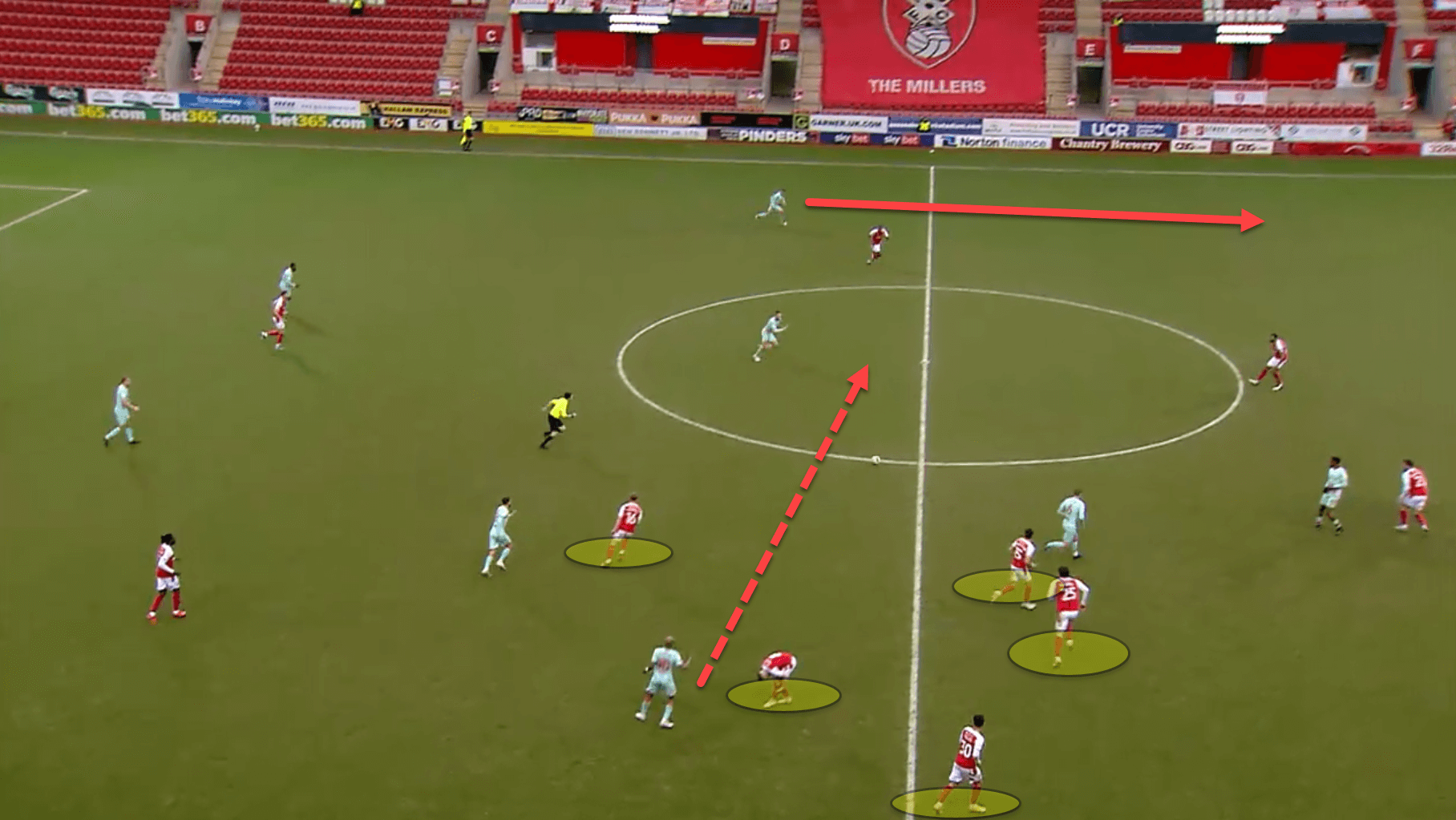
For example, Rotherham had just lost possession in this scenario and hunted with multiple players to regain the ball in an attempt to stop the counterattack. However, Swansea played through the counterpress, which gave them far too much space to attack into before eventually scoring.
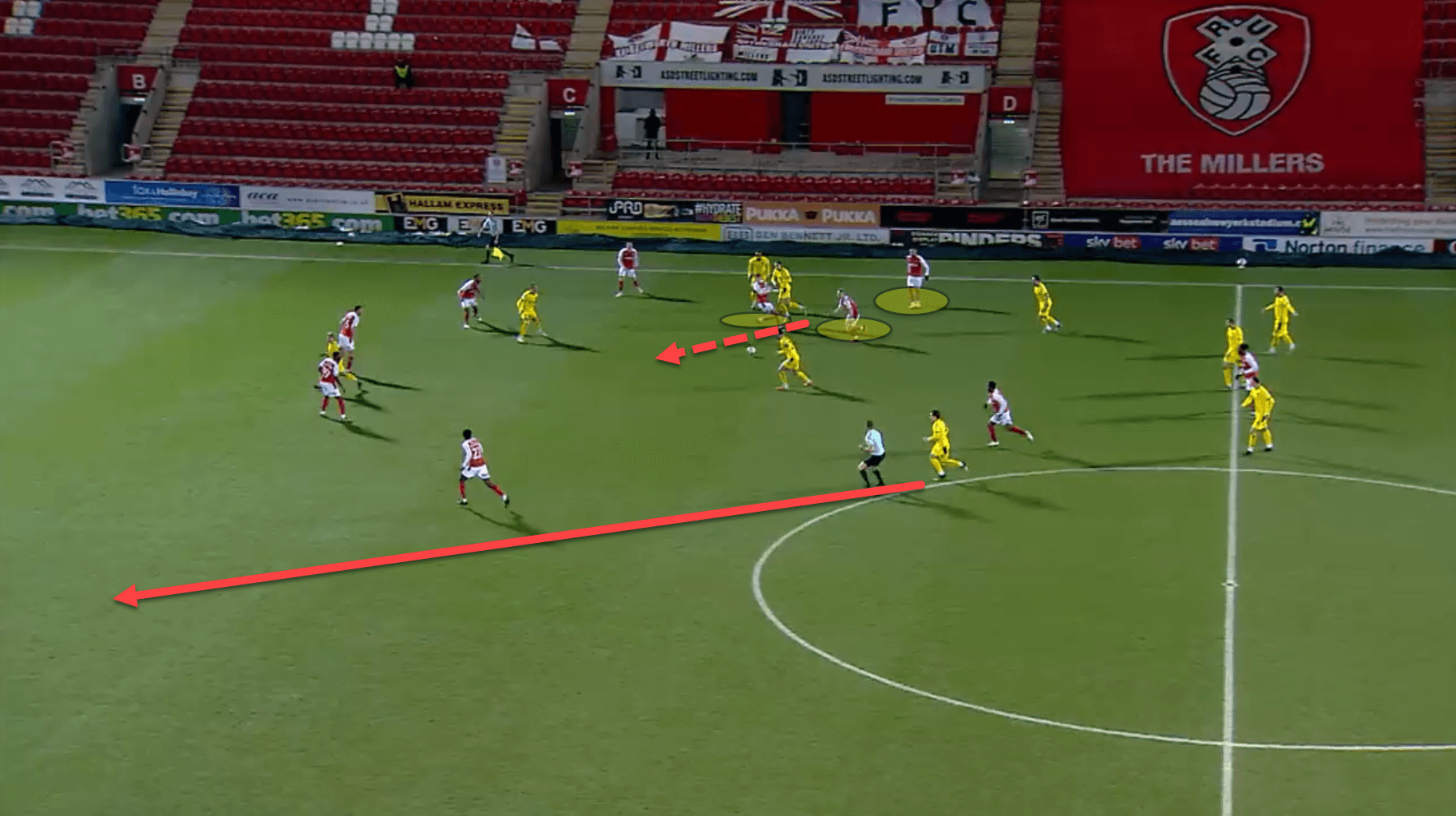
Again here, having failed to win back possession from their counterpress, Rotherham are carved open due to the gaps left by committing so many bodies, eventually conceding from a very similar situation as the last.
Counterpressing is certainly not the issue, but rather the number of bodies used in the press. Perhaps a better option for Warne’s side would be to counterpress with just one or two players at a time.
This reduces the possibility of regaining possession and will mainly just delay the counterattack rather than stop it, but it would allow them to get more bodies behind the ball and into their defensive shape to prevent the situations as shown above.
Conclusion
Their high pressing style of play is what makes Rotherham so unique and so the answer to solving their problems is certainly not to tear out the page and try something else. Tweaking their pressing structure could possibly enable them to be more stable defensively, in terms of being less man-oriented in the central corridors or less manic with the number of players they use while counterpressing.
Nonetheless, there are certainly plenty of positives from this structure which makes them fantastic to watch – arguably one of the most exciting sides in the division currently, and the Millers have been a great addition to the Championship due to their intense pressing style.

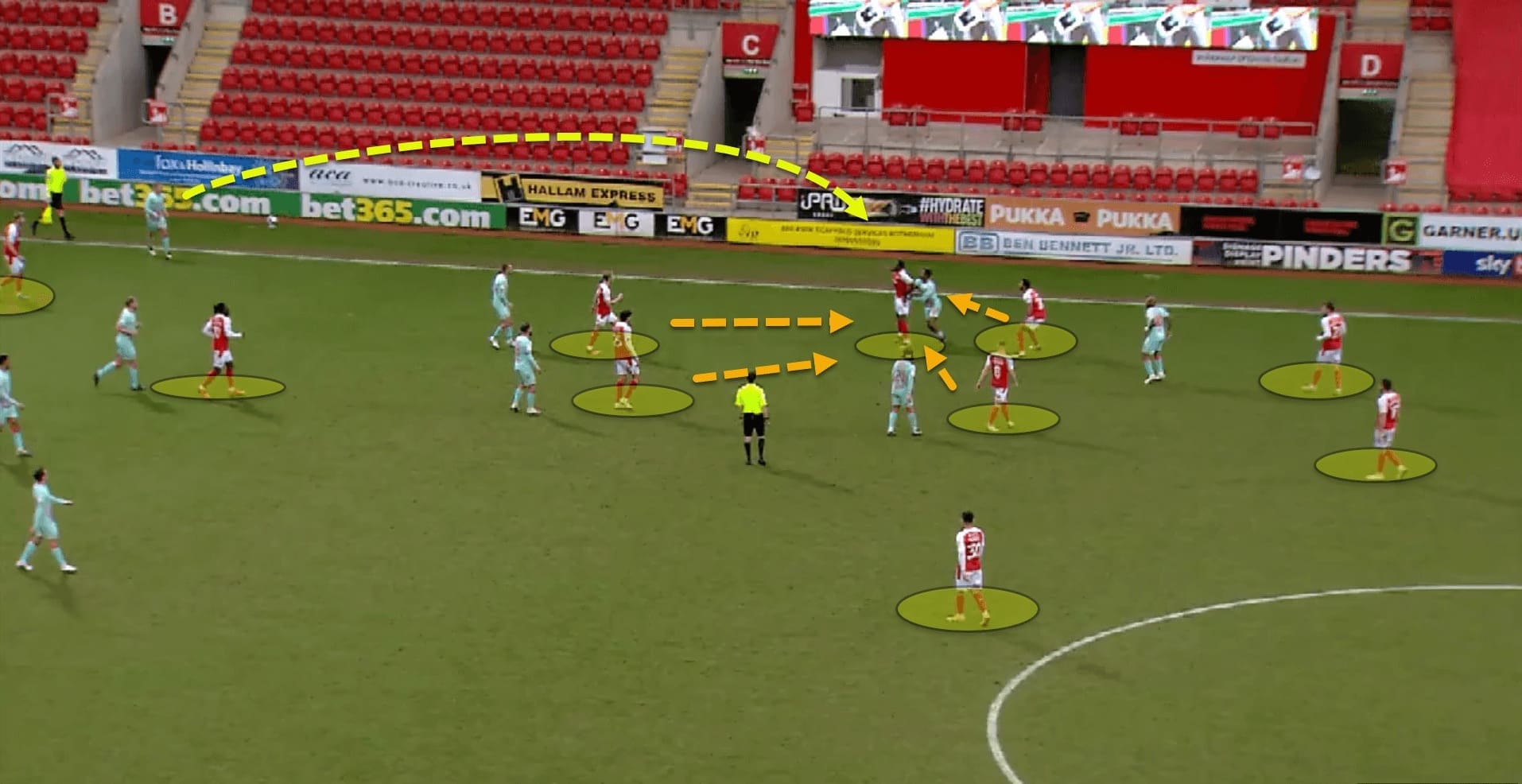




Comments